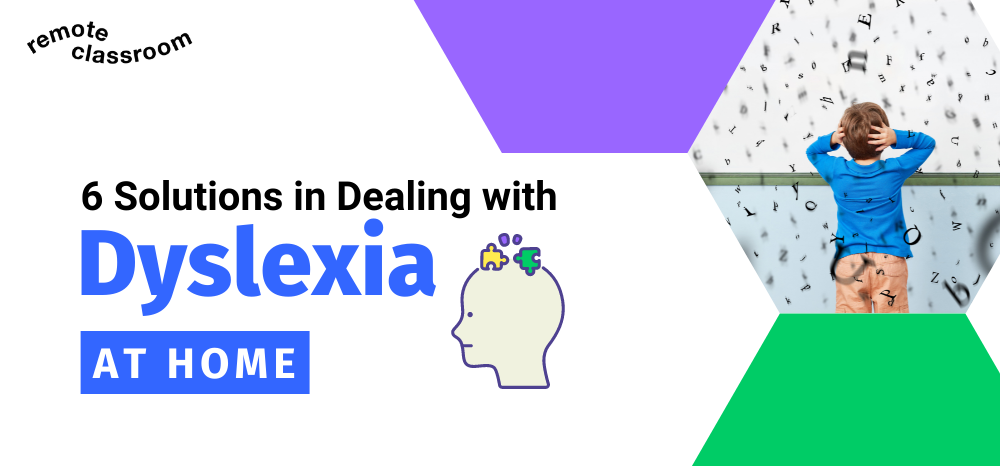As a homeschooler, your child learns and develops at their own pace. They will find dealing with certain skills like reading very challenging. But if learning to read becomes an ongoing struggle that leaves your child falling behind his peers, he may have a learning disorder known as dyslexia. With solutions like engaging them in auditory and reading exercises, maximizing their visual memory, and honing the skills they are good at, you’ll find homeschooling your dyslexic child the most rewarding.

A child trying to spell a word with letters via iStock
Being dyslexic is not synonymous with lack of intelligence. Dyslexia is clinically diagnosed as a difficulty in learning to read, that can present itself in writing, spelling, recognizing and sounding out words. Dyslexia can show as early as when a child turns three, but sometimes can turn out late, such as when your teenager suddenly finds it hard to learn a new foreign language, or often reads short words backwards.
Clinical findings show Dyslexia is more associated with heredity rather than mental retardation, and that as many as one in five kids has dyslexia. To date, there hasn’t been any prevention or cure, but it can be managed with special instructions and parental support.
It is encouraged that this problem should be addressed at the earliest time possible. Here are some ways to manage your dyslexic child at home:
Auditory Exercises
One of the best exercises for a dyslexic child is engaging them in auditory exercises like reading aloud to them, or letting them listen to music and audiobooks. Thanks to technology, exercises that help boost your child’s comprehension, and stimulate your child’s neural pathways are made available even within the comfort of your home.
Here are some available audiobooks online (and they’re free!):
NOTE: These are all legal sites that host public domain books. There’s more than enough great stuff in these libraries so check them reach out when you have the time!
Assisting them to read using a ruler
Studies also showed that using a ruler helps your kid read in a straight line, making them more attentive and recognized to the words presented before them. You can use any available ruler in your home, and you can also avail of special reading rulers in different colors to make reading more fun.
Making use of this inexpensive tool can help your child successfully overcome this complex reading difficulty. It provides a guideline of what part of the page your child is reading. As menial as this tool may be, it makes a huge difference to dyslexic readers who easily find themselves losing track of where they are on the page.
Maximizing their visual-spatial working memory
Through writing, reading, and spelling seem like a daunting task for your child, you can bank on their visual-spatial memory in targeting their problem areas. Having good visual working memory means they learn words as a unit rather than as an individual sound. For example, they may read the word “bullet” as part of reading but the word “bulletproof” would be hard to read if it were unfamiliar to them. So in teaching them to spell this word, you can present “bullet” as a photo, followed by the word “proof.”

Kid and her mother incorporating visual learning as a way to overcome dyslexia via iStock.
Renowned physicians noted that dyslexia can see things in their mind, in 3D perspective like many top architects and fashion designers and famous artists like Tommy Hilfiger, Johnny Depp, Keira Nightly, and Orlando Bloom have dyslexia.
Honing the skills they are good at
Homeschooling kids with dyslexia can be difficult, both for the child and the parent. A child may be too hard on himself when feels like he can’t do a task. While a parent may be disheartened seeing their child in such a situation, it is suggested that aside from engaging them in traditional subjects, dyslexic kids should be given more freedom in choosing their crafts, hobbies, and sports.
Studies show that looking for a skill your child can excel at make learning more engaging and stress-relieving. It allows them to grow naturally into their gifts and talents without the pressures of trying to learn in ways they can’t learn at a pace they can’t keep.
Giving them extra love and encouragement
Kids with dyslexia may feel that they’re not as smart as their peers because it’s difficult to keep up. As they move through their schooling, problems can get worse as reading becomes more important to learning. Kids who have difficulty often avoid reading because it’s hard or stressful. One of the most important solutions in dealing with dyslexic children is your patience and support.
Read more: Ways Parents Can Help their Kids Thrive in Remote Learning
While you can get a private tutor or a reading specialist to tend to your child, you can make your child feel supported by encouraging and assisting in reading at home. You can assist your child with their modules.
Enrolling them in a Dyslexic-Friendly Curriculum
Being able to customize an education to your child’s specific needs is what homeschooling is all about; having the right blend of teaching style and a keen understanding of how your child learns best. For instance, you have complete control over the materials you teach with. You can even choose a targeted homeschool curriculum for dyslexia.
Gadgets and technology are around but still the keyword when dealing with a dyslexic child is patience. They may find it frustrating in dealing with the disadvantages that come with it. But with the right amount of care, love and attention, you can help your child overcome dyslexia little by little. Our children is our wealth and we take care, nurture, love them for who they are.
Remote Classroom adjusts to your child’s specific needs, making sure they express their own creativity and gifts through a wide variety of classes that will keep them inspired to learn more. We offer live online lessons on Arts, Coding & Tech, Health & Wellness, English, Maths, Science & Nature, Music, and Life Skills. Send us a message on Facebook to learn more about getting your kids set up for homeschooling.

